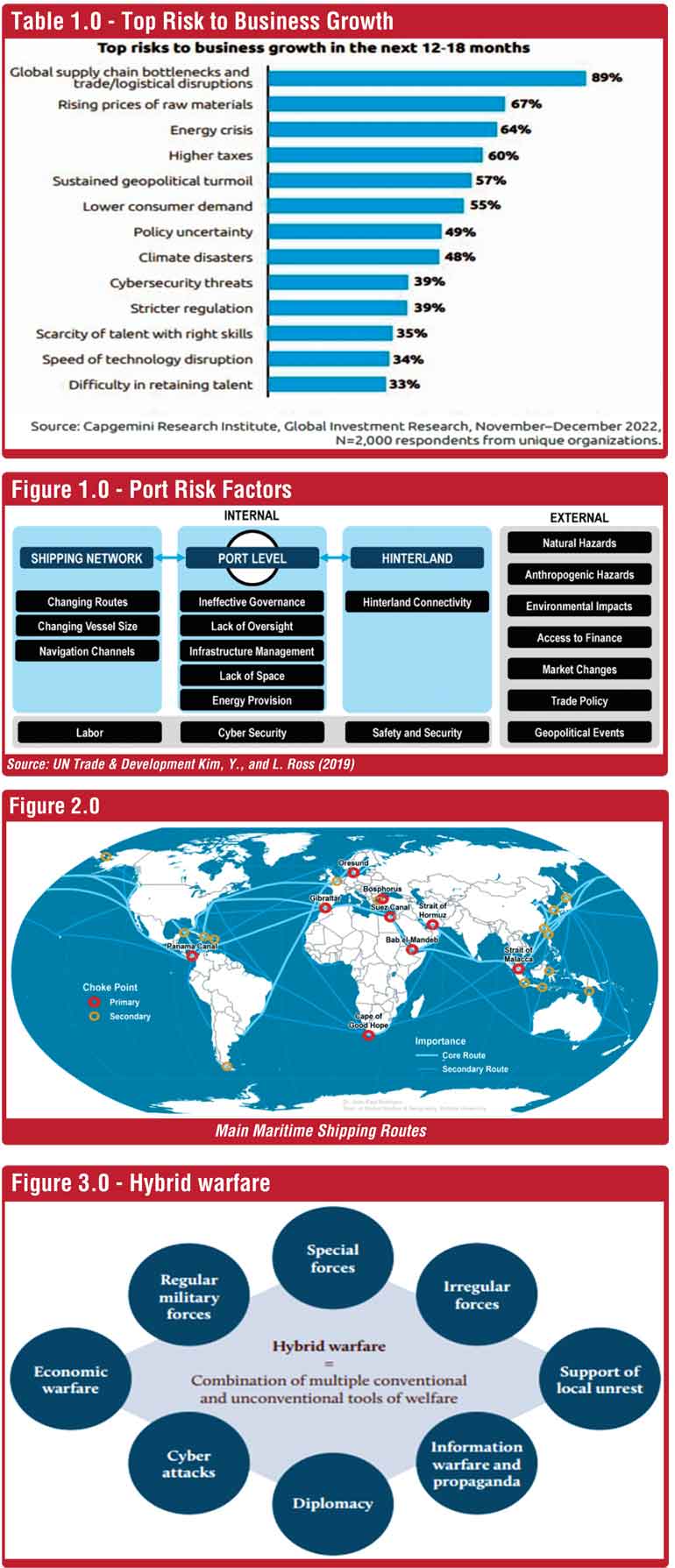Thursday Apr 03, 2025
Thursday Apr 03, 2025
Saturday, 18 January 2025 00:07 - - {{hitsCtrl.values.hits}}
 The world has evolved commercially and in terms of civilisation, largely due to exploring new trade routes. However, this progress has also created challenges among nations, driven by the intense influence of geopolitics. Commercial seaports play a crucial role in global trade and economics. Their importance goes beyond transportation; they are deeply connected to the complex dynamics of geopolitics. Understanding this relationship is essential for navigating the challenges and opportunities that arise in international relations and trade policies. Currently, the global geopolitical landscape is dominated by the country with the most significant port power.
The world has evolved commercially and in terms of civilisation, largely due to exploring new trade routes. However, this progress has also created challenges among nations, driven by the intense influence of geopolitics. Commercial seaports play a crucial role in global trade and economics. Their importance goes beyond transportation; they are deeply connected to the complex dynamics of geopolitics. Understanding this relationship is essential for navigating the challenges and opportunities that arise in international relations and trade policies. Currently, the global geopolitical landscape is dominated by the country with the most significant port power.
Global trade and its reliance on supply chains are complex subjects that can be difficult to understand. Terms like “onshoring,” “reshoring,” and “nearshoring” have been common for some time, but a new term has emerged in recent years: “friend-shoring.” The recent series of drone and missile attacks by the Houthis targeting ships in the Red Sea highlights the significance of oceans in the international order. With the Indo-Pacific region as indicated by its name, encompassing two of the world’s largest oceans becoming pivotal in shaping global geopolitics, we are entering a “new era of global sea power.”
At this critical juncture in history, it is essential to revisit the concept of ‘seapower.’ The seapower is not determined by the number of ships or personnel it has to use for naval purposes alone but also includes its capacity to use the ships for civilian purposes. The vital component of seapower refers to the country’s ability to influence the behaviour of other maritime actors. Therefore, in essence, sea power encompasses naval power along with the non-military aspects, namely political, economic, and diplomatic uses of the sea.
A country like Sri Lanka is sandwiched between world powers due to its prominent location and strategic maritime position. This has sometimes led to regime changes and hindered the implementation of a non-aligned international policy. Table 1.0 and Figure 1.0 show how important the sea route is in case of disruptions due to natural and man-made issues. Several internal and external risk factors to the maritime transport sector, or the port ecosystem, can become disruptive and test a port’s resilience.
Measuring port power
To gain a deeper insight into the dynamics of port geopolitics and to empower states in enhancing their strategic positioning while effectively addressing potential challenges, there are key geopolitical factors vital for evaluating port power.
Strategic significance of ports
As we are aware, global sea routes include five of the most important ocean thoroughfares for global trade. These include the English Channel, the Malacca Strait, the Hormuz Strait, the Suez Canal, and the Panama Canal. These chokepoints are also vulnerable to current political and climatic issues. The escalation of conflict in the Middle East could threaten global and European energy supplies. The Strait of Hormuz is a crucial chokepoint for global energy transit, with 30% of the world’s oil and 20% of the global liquefied natural gas trade passing through it daily. Emerging and strategically important ports.
The port of Alexandroupolis
Following Russia’s invasion of Ukraine, the small Greek Aegean port of Alexandroupolis, located close to the Bulgarian and Turkish borders, has emerged as a logistic and military hub serving the Western containment and deterrence strategy towards Russia. In this respect, it has been characterised as “vital” by various officials, analysts, and media. Yet, its strategic significance had already started growing well before 24 February 2022.
Djibouti ports
Port hinterland connectivity and multimodal logistics in Africa and the role of Djibouti ports in the gate access into East Africa. Port is to integrate effective hinterland connectivity mainly in Africa and Europe
United Arab Emirates
The UAE is a federation of seven emirates, situated in the southeast of the Arabian Peninsula, bordering the Gulf of Oman and the Persian Gulf, between Oman and Saudi Arabia. All the emirates, except Fujairah, have a frontage along the Persian Gulf. With direct geographic access to the Arabian. Gulf, the UAE’s location confers upon it a central position in facilitating maritime trade across the region. Moreover, the UAE has developed access to the Red Sea through strategic port investments and military bases along the chokepoints of the Bab al-Mandab, one of the most important global shipping lanes.
The Arctic hub ports
The Arctic network of hubs highly simplifies and integrates navigation and transportation between key locations in the East and West. The Northern Sea Route (NSR) is emerging as a critical maritime corridor, offering a shorter path between Europe and Asia via the Arctic Ocean. Russia plans to commence year-round navigation on the NSR by 2025, marking a historic milestone. This initiative is part of a broader goal to increase cargo traffic to 200 million tonnes by 2030.
Haifa Port in Israel
Sitting on the shores of the Mediterranean, Haifa Port has served as a major hub for seafarers from North Africa and Asia for hundreds of years. Haifa was historically a strategic port in the past. Once, Secretary of State US Mike Pompeo mentioned “We want the Chinese people to be successful, but we don’t want the Chinese Communist Party to have access to Israeli infrastructure and to Israeli communication systems – Finally, the consortium, led by Adani Group, secured the rights to purchase 100% shares of Haifa Port Company Ltd., solidifying their presence in the Mediterranean region.
Chancay port in Peru
China’s influence in Latin America grows as a new mega-port opens in Peru. The Chancay port, a $ 3 billion investment, creates a direct route across the Pacific Ocean. Peruvian and Chinese officials celebrate the project as a game-changer for Peru’s trade with its largest partner. The Chancay Port is expected to drastically reduce logistics costs and transport times for Peruvian exports to the Asia/Pacific region, significantly enhancing Peru’s trade and investment prospects. China’s involvement in Chancay has raised US concerns about potential military use: China’s investment underscores its growing influence in Latin America, raising strategic concerns for the US as it seeks to balance this influence regionally
Shahid Beheshti Port Terminal at Chabahar Port Iran
Recently, India signed a 10-year agreement with Iran for the development of the Shahid Beheshti Port Terminal at Chabahar Port. The port will minimise the distance from India’s west coast to landlocked Afghanistan, Central Asia, and European nations bypassing Pakistan. These developments showcase the rising importance of ports not only as an economic aspect but also as a strategic tool of geopolitics.
Gwadar port – Pakistan
Gwadar port is the warm water and deep sea port of Pakistan. It is situated at the mouth of the Persian Gulf, Strait of Hormuz, and holds two-third world oil reserves. Asia, the largest region has many landlocked countries, and their access to sea via their land route is very costly. Such countries look out for the shortest routes for international trade. China is an example whose western part is a thousand kilometres away from its Eastern seaports. Through the Pakistan-China Economic Corridor (CPEC), China would benefit from the nearest Gwadar port. Kashgar is 4500 Km while Gwadar is 2800 km from the Port of Shangai. There are security concerns which need to be addressed. Presently, India is using all tactics to counter the development of Gwadar port.
Sri Lanka – Colombo, Hambantota, Trincomalee
Sri Lanka enjoys a unique and advantageous position, being surrounded by the sea, which provides it with significant strategic advantages through its commercial ports on the west, east, and south coasts. Given its pivotal location in the Indian Ocean, Sri Lanka is likely to continue garnering international interest, particularly from nations such as India, China, and Japan. How the country skilfully navigates these relationships will play a crucial role in shaping its long-term economic and geopolitical path. Looking ahead, Sri Lanka’s maritime interests are poised for growth, particularly in sectors such as transshipment hubs, maritime services, fisheries, offshore energy and resources, undersea infrastructure, and tourism. Emphasising collaboration and mutual benefit in these areas will be essential for fostering sustainable development and enhancing regional stability.
Impacts of the strategic use of ports
Hybrid warfare on seaport and geopolitics
This diagram depicts how superpowers could be used to disrupt and influence countries that are rich in seaports and strategic locations.
The strategic location of Sri Lanka, along with its valuable seaports, highlights the complexities of regional geopolitics. It’s essential for the country to navigate these challenges carefully to avoid the pitfalls of hybrid warfare. By strengthening diplomatic ties and enhancing its defence capabilities, Sri Lanka can work towards ensuring its sovereignty and stability in a changing geopolitical landscape. In this context, Sri Lanka could benefit from adopting a strategic and balanced approach to managing the interests of major nations seeking access to its waters for various projects and business ventures.
In times of uncertainty, it would be prudent for the Government to engage in transparent and inclusive dialogue with all stakeholders, ensuring its position is clearly articulated rather than attempting to accommodate each nation individually. Therefore, Sri Lanka’s survival and success depend on a careful balancing act. The Government should prioritise national sovereignty and self-respect while fostering cooperative and mutually beneficial relationships with superpowers. By leveraging its strategic location, diversifying partnerships, and maintaining a focus on domestic resilience, Sri Lanka can ensure its long-term stability and prosperity.

Discover Kapruka, the leading online shopping platform in Sri Lanka, where you can conveniently send Gifts and Flowers to your loved ones for any event including Valentine ’s Day. Explore a wide range of popular Shopping Categories on Kapruka, including Toys, Groceries, Electronics, Birthday Cakes, Fruits, Chocolates, Flower Bouquets, Clothing, Watches, Lingerie, Gift Sets and Jewellery. Also if you’re interested in selling with Kapruka, Partner Central by Kapruka is the best solution to start with. Moreover, through Kapruka Global Shop, you can also enjoy the convenience of purchasing products from renowned platforms like Amazon and eBay and have them delivered to Sri Lanka.
Discover Kapruka, the leading online shopping platform in Sri Lanka, where you can conveniently send Gifts and Flowers to your loved ones for any event including Valentine ’s Day. Explore a wide range of popular Shopping Categories on Kapruka, including Toys, Groceries, Electronics, Birthday Cakes, Fruits, Chocolates, Flower Bouquets, Clothing, Watches, Lingerie, Gift Sets and Jewellery. Also if you’re interested in selling with Kapruka, Partner Central by Kapruka is the best solution to start with. Moreover, through Kapruka Global Shop, you can also enjoy the convenience of purchasing products from renowned platforms like Amazon and eBay and have them delivered to Sri Lanka.